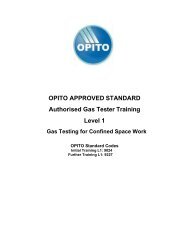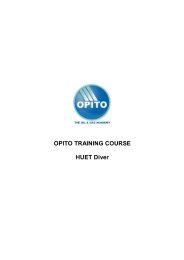Stress levels associated with huet - Opito
Stress levels associated with huet - Opito
Stress levels associated with huet - Opito
Create successful ePaper yourself
Turn your PDF publications into a flip-book with our unique Google optimized e-Paper software.
4.5 IMPACT OF STRESS ON HEALTH STATUS<br />
<strong>Stress</strong> due to exits<br />
OPITO<br />
As described earlier, stress generally means the mental and physical response of the<br />
body to demands placed upon it. There is an optimal level of arousal that means that a<br />
little stress will help the body to react to a challenge or threat, whereas an excessive<br />
response to a stressor can have negative effects.<br />
When considering the health impact of stress, the main concern for most people, and the<br />
concern <strong>with</strong> the greatest potential impact is the risk of coronary heart disease. There are<br />
now known to be many coronary risk factors. Action can be taken by the individual to<br />
reduce some of the major factors that include smoking, high blood pressure, high blood<br />
cholesterol and physical inactivity. The main risk factors particularly <strong>associated</strong> <strong>with</strong><br />
sudden cardiac death are reported to be an elevated resting heart rate (≥ 90 beats/min),<br />
heavy drinking and arrhythmia/irregular heart beat (Shaper et al, 1993; Wannamethee et<br />
al, 1995).<br />
Most of the literature considering the effects of stress on coronary health focuses on<br />
chronic psychosocial stressors such as work control, personal relationships and life<br />
events such as bereavement. Effects of anxiety on the risk of coronary heart disease<br />
have concentrated on trait anxiety, referring to how prone an individual may be to anxiety<br />
and differences between people in their background tendency to respond to perceived<br />
threatening situations. A number of large prospective studies have shown an association<br />
between chronic anxiety and fatal coronary heart disease, in particular, sudden cardiac<br />
death (Haines et al, 1987; Kawachi et al, 1994; Albert et al, 2005). There are a number of<br />
possible causes. It has been suggested that acute stress, such as bereavement, may<br />
trigger irregular heart rhythms and myocardial ischaemia (restricted blood flow to the<br />
tissues of the heart) (Rozanski et al, 1999). Rozanski et al (1999) recognised that<br />
psychosocial stresses tend to cluster together and when they do so, the resultant risk for<br />
cardiac events is often substantially elevated. These authors also commented on the<br />
impact of 'sudden' stressors (e.g. a high work-load exercise test <strong>with</strong>out warm-up)<br />
compared to 'graded stressors (e.g. graded exercise test <strong>with</strong> increasing work-loads). It is<br />
significant that the severity of cardiac events found in the graded stressor was much less<br />
than that found <strong>with</strong> the sudden stressor. It can therefore be supposed that 'graded'<br />
training will benefit the health of trainees. It has also been recognised that psychological<br />
factors usually have no acute deleterious effects in the normal heart, whereas in the<br />
diseased heart, the consequences may be hazardous (Hartel, 1987). In many cases of<br />
sudden death, there was a history of previous myocardial infarction or known<br />
cardiovascular disease (Greene et al, 1972).<br />
A lower level of risk was proposed by Bunker et al (2003). An Expert Working Group of<br />
the National Heart Foundation of Australia undertook a systematic review of the evidence<br />
relating to major psychosocial risk factors to determine whether there were any<br />
independent associations between any of the risk factors and the development or<br />
progression of coronary heart disease or the occurrence of acute cardiac events. The<br />
group fond "no strong or consistent evidence for a causal association between chronic life<br />
events, work-related stressors (job control, demands and strain), Type A behaviour<br />
patterns, hostility, anxiety disorders or panic disorders and coronary heart disease". They<br />
compared the increased risk contributed by these factors as being of similar order to<br />
factors such as smoking and hypertension.<br />
Whatever the true level of risk, it should be recognised that psychosocial support, regular<br />
exercise, stress reduction training, a sense of humour and optimism have all been cited as<br />
means of reducing the risks of stress on cardiovascular health (Das & O'Keefe, 2006).<br />
SC/MD/OPITO/063301 10.11.2006 Page 13 of 31




